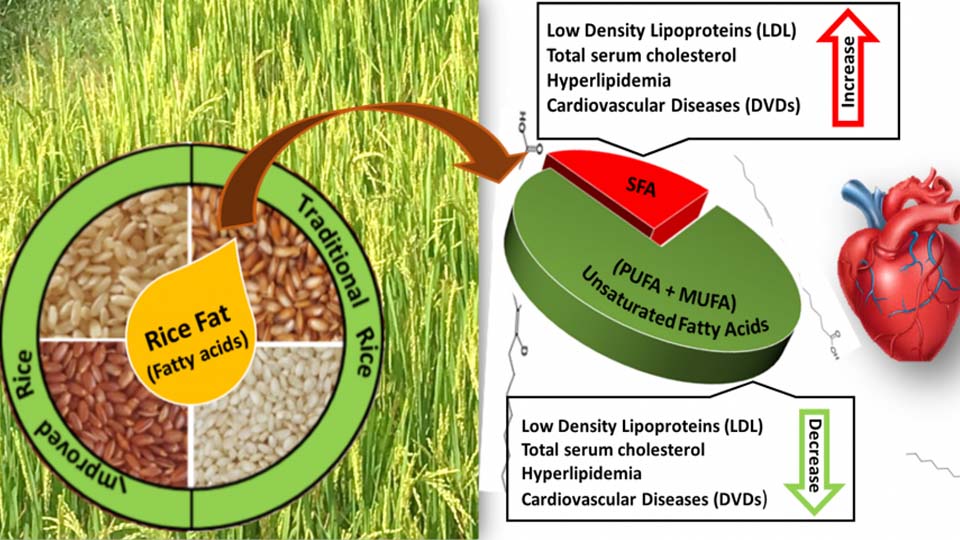Profiling fatty acids in rice for ascertaining human nutrition and health
Rice is the dietary staple for half of the world population. In most Asian countries, the annual per capita consumption of rice is greater than 110 kg and it is reported to provide major nutrients namely carbohydrates, proteins, vitamin B1 (thiamine), B2 (riboflavin), B3 (niacin), and also fat in significant quantities. Further, the contribution of rice towards the dietary fat intake in some Southeast Asian countries is high as 17 – 27%. Nutritionally, foods with low quantities of saturated fatty acids (SFA) and high quantities of unsaturated fatty acids are favorable for the management of hyperlipidemia, cardiovascular diseases, and related complications. Unlike most other foods, rice contains more unsaturated fatty acids i.e., monounsaturated fatty acids (MUFA) and polyunsaturated fatty acids (PUFA) than saturated fatty acids (SFA) and therefore can be considered a nutritionally rich dietary staple in terms of fatty acid profile. Further, it has been shown that rice is abundant in linoleic acid, an essential fatty acid for humans. Therefore, rice and rice-incorporated food products may use to serve as a vehicle for the prevention and management of diseases associated with bad lipid profiles and related complications such as hyperlipidemia, cardiovascular diseases, etc.
In Sri Lanka rice is the dietary staple; per capita consumption is around 107 kg/year. Sri Lanka has a long history of rice cultivation, and the country holds more than 2000 traditional and nearly 60 new improved rice varieties. Research conducted during the last 10-12 years in Sri Lanka has shown that variation in nutritional composition and other important biological activities of Sri Lankan rice is highly dependent on the rice variety, presence of pigments in the rice grain (pigmented and non-pigmented rice) and traditional or new improved rice varieties. Therefore, the identification of rice varieties with healthy fatty acid profiles is immensely valuable for healthy dietary intervention.
Since scientific data on fatty acid profiles of Sri Lankan rice is extremely limited, this research was conducted to evaluate the fatty acid profiles of a range of pigmented and non-pigmented commercially cultivating traditional and new improved rice varieties of Sri Lanka. Seven traditional (Herath Banda, Pachchaperumal, Kurulu Thuda, Rathel, Kalu Heenati, Suwadel, and Madathawalu) and eight new improved rice varieties (Bg 300, Bg 352, At 362, At 311, At 307, At 308, Bg 360 and Bw 272-6b) cultivated in the paddy fields of Rice Research and Development Institute (RRDI), Batalagoda, Sri Lanka were used for the present study. To evaluate fatty acid profiles, fat was extracted from whole grain rice flour using the automated Soxhlet fat extraction method, derivatized to methyl esters, and finally analyzed by gas chromatography-flame ionization detection (GC-FID).
The fat and fatty acid profiles significantly differed among the studied rice varieties. Total fat content varied from 2.20-3.22 % and was highest in new improved red rice variety, Bw 272-6b. The lowest fat content was exhibited in the traditional red rice variety, Kurulu Thuda. All the studied rice varieties comprised more unsaturated fatty acids (MUFA and PUFA) compared to saturated fatty acids and the highest unsaturated fatty acid content was observed in Bw 272-6b variety. The most predominant fatty acids present in rice were oleic, linoleic, and palmitic acids. Interestingly, these three fatty acids together comprised 90-96% of the total fatty acids present in tested rice varieties of Sri Lanka. The essential fatty acid, linoleic was highest in a new improved red rice variety Bw 272-6b and a traditional white rice variety Rathel. A commonly used index for evaluating the impact of food on cardiovascular diseases is PUFA/SFA ratio and the generally recommended value for dietary foods is ≥ 0.4. The PUFA/SFA ratio of tested rice varieties varied from 1.22 to 1.63. In general, nutritionally sound healthy rice varieties were observed in both traditional and new improved rice varieties as well as in both red and white rice varieties of Sri Lanka. Interestingly, differences among rice varieties in terms of fatty acid profiles were due to differences in individual fatty acids in rice varieties irrespective of traditional or new improved and red or white rice varieties. Thus, the findings of the present study clearly showed that nutritionally sound healthy rice varieties can be selected by studying their total fatty acid profile.
This is the first study to report the total fatty acid profile of a large set of Sri Lankan rice varieties and report differences among fatty acid profiles of traditional and new improved rice varieties the world over. Moreover, the findings of the present study may be beneficial for nutritionists, researchers, and rice breeders in nutritional intervention programs, diet planning, research and development, product development, and new varietal development.
This research was conducted at the Industrial Technology Institute (ITI), Sri Lanka in collaboration with the University of Colombo (UOC) and Rice Research and Development Institute (RRDI), Batalagoda, Sri Lanka, and was funded by Treasury, Sri Lanka (Grant No: TG 18/146). This study was conducted as a part of the MPhil/PhD degree of Ms. Madara Samaranayake (Research Scientist, ITI) under the supervision of Senior Prof. Ranjith Mahanama (Department of Chemistry, Faculty of Science, UOC), Senior Lecturer, Dr. Kanchana Abeysekera (Department of Agricultural Technology, Faculty of Technology, UOC), Prof. Ilmi Hewajulige (Additional Director General, Research & Development, ITI) and Dr. Sudarshana Somarisi (Additional Director General, Technical Services, ITI). Special thanks go to Dr. Jayantha Senanayake (The Director, RRDI, Batalagoda) for providing rice samples for the study.
Reference:
Samaranayake, M.D.W., Abeysekera, W.K.S.M., Hewajulige, I.G.N., Somasiri, H.P.P.S., Mahanama, K.R.R. and Senanayake, D.M.J.B., G.A.S. Premakumara (2022). Fatty acid profiles of selected traditional and new improved rice varieties of Sri Lanka. Journal of Food Composition and Analysis, 112, 104686.
https://doi.org/10.1016/j.jfca.2022.104686
Imaged and written by: Madara Samaranayake

